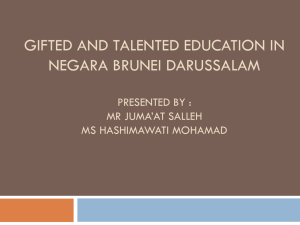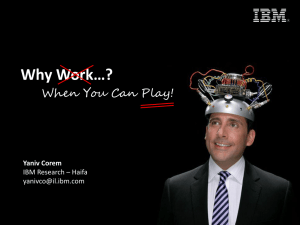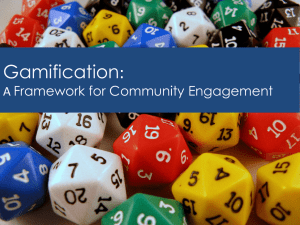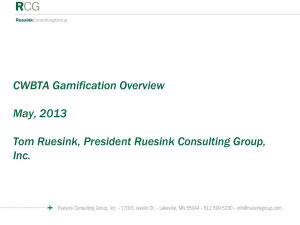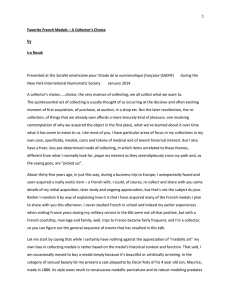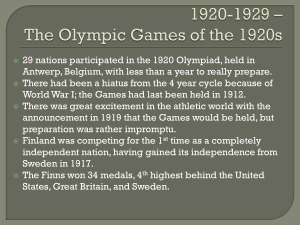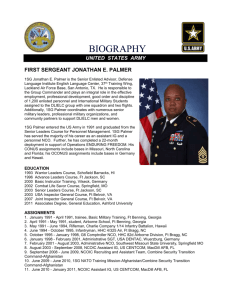COMP-224
advertisement
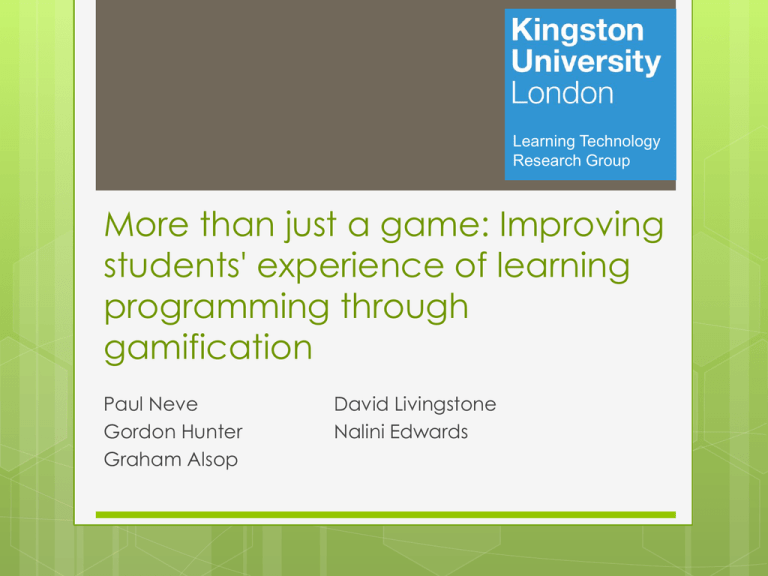
Learning Technology Research Group More than just a game: Improving students' experience of learning programming through gamification Paul Neve Gordon Hunter Graham Alsop David Livingstone Nalini Edwards "Computer science is more than programming, but programming is an absolutely central process for Computer Science" The Computing At Schools Group, 2012 21% the amount of students able to program at the end of the first year of their degree course in computing -McCracken et al, 2001 71% the failure rate in computing subjects at one American university where computing was "the second-largest major" -Bennesden and Caspersen, 2007 boring, difficult and irrelevant terms used by students to describe programming -Jenkins, 2002 -Anderson et al, 2008 Technology Enhanced Learning is not a magic bullet Gamification "the use of (computer) game elements in non-game contexts" -Deterding et al, 2011 "Finish a level" rather than "complete a workshop" "Win a medal" or "Unlock an achievement" rather than "get a mark" "Level up" rather than "move onto the next workshop activity" Gamification in programming pedagogy and TEL - examples CodeAcademy RoboProf Microworlds “Manual” gamification Well known, very trendy current and gamification is inherent… but it’s the M’est and O’est MOOC possible! e.g. Scratch - these share conceptual aspects with certain genres of games in that one must navigate an in-game avatar around a virtual world Java activities divided into “levels” – inspired by classic text-based adventures -Daly and Horgan 2004 Thamvichai and SupnakornDavila (2012) designed their course and activities to include concepts such as “losing a life” and “leveling up” NoobLab – the story so far This is NoobLab (think CodeAcademy on steroids!) NoobLab – the story so far Intelligent feedback: feedback in English like a human tutor, contextually aware, and doesn't take the form of an inscrutable error message NoobLab – the story so far Monitoring student progress and informing pedagogy Students' routes through learning material can be correlated with other metrics Common patterns can inform pedagogy, provide advanced warning of at-risk students, and be used as feedback triggers Gamifiying NoobLab A Microworld for Thinking Like a Programmer Make concepts such as repetition and conditional processing visual Conceptual similarities with games where one must navigate an in-game avatar around a virtual world Carol the Robot • • • Inspired by Stanford's "Karel" Teaches "thinking like a programmer" through engaging visual problems Also teaches C-like syntax and grammar through stealth Gamifiying NoobLab A game-style award system based around “medals” Bronze, Silver and Gold medals for each practical activity Medals used summatively "Ribbons" were awarded for formative work Gamifiying NoobLab Cohort wide high score table increases engagement through competition The results: interesting numbers 28 respondents to an end of module questionnaire Every one of them agreed that the changes to NoobLab had a positive or highly positive effect 25 out of 28 agreed with the statement "I felt I had to get a gold for every medal in NoobLab" The results: student feedback On the medal system and high score table system: "(it) was a big plus point… there is an engagement factor in earning the medals… I've also noticed students who maybe aren't so adept in other modules really focusing on earning medals" "I play a lot of sport… as a highly competitive person it was the incentive I needed to sit down and actually complete the work" The results: tutor observations It brought out the best from proficient students some carried on winning medals well after clocking up enough points to get a 100% mark! …but some burnt through all available material in one sitting then twiddled their thumbs until new stuff was available The results: tutor observations Students obsessed over getting gold and also over formative "ribbons" when they were available The results: tutor observations Some weaker students became dependent on the medal system to test code "what's a main method?" Some were engaging in the "trial and error" approach going for a medal despite never having run the code! "I didn't get the medal – it must be broken" The results: tutor observations Some gaming concepts created misconceptions On many games, if you put in enough time you will eventually "level up" Some weaker students felt they "deserved" medals based on the same criteria "I've been working on this one for hours now, I should get the medal for all that work…?" Conclusions Gamification in TEL offers great potential for increasing engagement It is really cool when you see a student fling both arms aloft and shout "YES" when they get a medal BUT… a TEL platform is not a computer game Conclusions Game concepts can map onto educational activities… …but… ...such concepts can alter students' perceptions of the activities Gamification does seem to increase motivation and engagement, and students enjoy it – but there can be downsides to it

